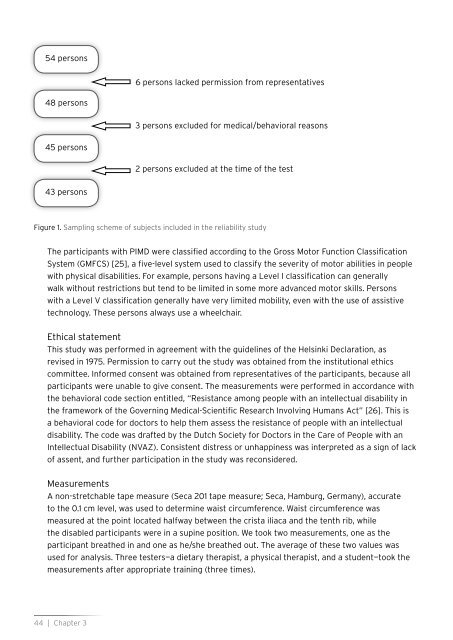Measuring physical fitness in Persons with Severe/Profound ...
Measuring physical fitness in Persons with Severe/Profound ...
Measuring physical fitness in Persons with Severe/Profound ...
- No tags were found...
You also want an ePaper? Increase the reach of your titles
YUMPU automatically turns print PDFs into web optimized ePapers that Google loves.
54 persons6 persons lacked permission from representatives48 persons3 persons excluded for medical/behavioral reasons45 persons2 persons excluded at the time of the test43 personsFigure 1. Sampl<strong>in</strong>g scheme of subjects <strong>in</strong>cluded <strong>in</strong> the reliability studyThe participants <strong>with</strong> PIMD were classified accord<strong>in</strong>g to the Gross Motor Function ClassificationSystem (GMFCS) [25], a five-level system used to classify the severity of motor abilities <strong>in</strong> people<strong>with</strong> <strong>physical</strong> disabilities. For example, persons hav<strong>in</strong>g a Level I classification can generallywalk <strong>with</strong>out restrictions but tend to be limited <strong>in</strong> some more advanced motor skills. <strong>Persons</strong><strong>with</strong> a Level V classification generally have very limited mobility, even <strong>with</strong> the use of assistivetechnology. These persons always use a wheelchair.Ethical statementThis study was performed <strong>in</strong> agreement <strong>with</strong> the guidel<strong>in</strong>es of the Hels<strong>in</strong>ki Declaration, asrevised <strong>in</strong> 1975. Permission to carry out the study was obta<strong>in</strong>ed from the <strong>in</strong>stitutional ethicscommittee. Informed consent was obta<strong>in</strong>ed from representatives of the participants, because allparticipants were unable to give consent. The measurements were performed <strong>in</strong> accordance <strong>with</strong>the behavioral code section entitled, “Resistance among people <strong>with</strong> an <strong>in</strong>tellectual disability <strong>in</strong>the framework of the Govern<strong>in</strong>g Medical-Scientific Research Involv<strong>in</strong>g Humans Act” [26]. This isa behavioral code for doctors to help them assess the resistance of people <strong>with</strong> an <strong>in</strong>tellectualdisability. The code was drafted by the Dutch Society for Doctors <strong>in</strong> the Care of People <strong>with</strong> anIntellectual Disability (NVAZ). Consistent distress or unhapp<strong>in</strong>ess was <strong>in</strong>terpreted as a sign of lackof assent, and further participation <strong>in</strong> the study was reconsidered.MeasurementsA non-stretchable tape measure (Seca 201 tape measure; Seca, Hamburg, Germany), accurateto the 0.1 cm level, was used to determ<strong>in</strong>e waist circumference. Waist circumference wasmeasured at the po<strong>in</strong>t located halfway between the crista iliaca and the tenth rib, whilethe disabled participants were <strong>in</strong> a sup<strong>in</strong>e position. We took two measurements, one as theparticipant breathed <strong>in</strong> and one as he/she breathed out. The average of these two values wasused for analysis. Three testers—a dietary therapist, a <strong>physical</strong> therapist, and a student—took themeasurements after appropriate tra<strong>in</strong><strong>in</strong>g (three times).44 | Chapter 3











